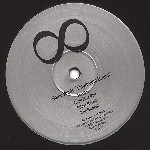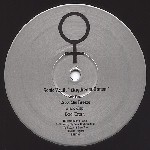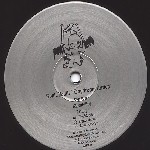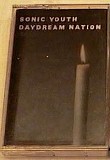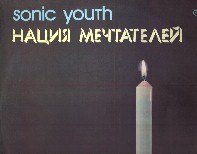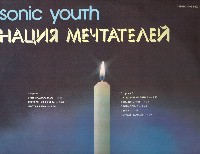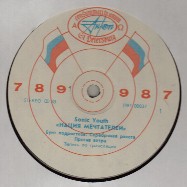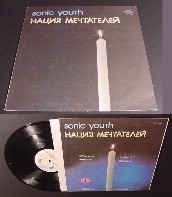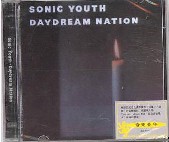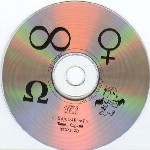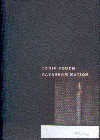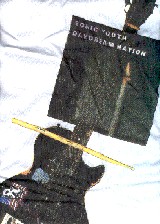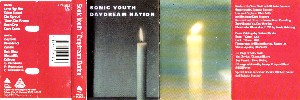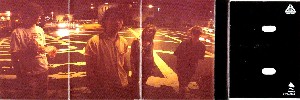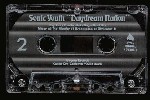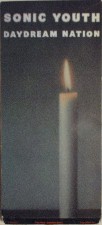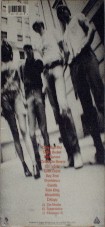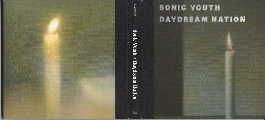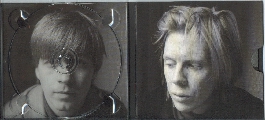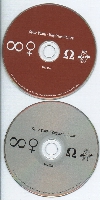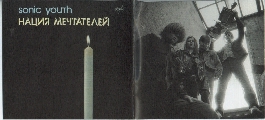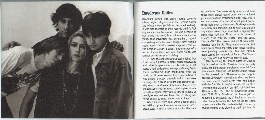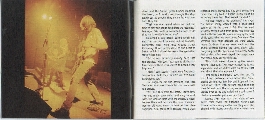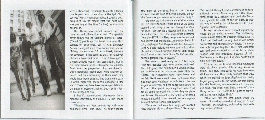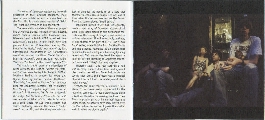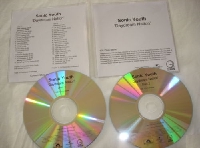| 1. | Teen Age Riot | 6:57 | |
| 2. | Silver Rocket | 3:47 | |
| 3. | The Sprawl | 7:42 | |
| -- | |||
| 4. | 'Cross The Breeze | 7:00 | |
| 5. | Eric's Trip | 3:48 | |
| 6. | Total Trash | 7:33 | |
| 7. | Hey Joni | 4:23 | |
| 8. | Providence | 2:41 | |
| 9. | Candle | 4:58 | |
| 10. | Rain King | 4:39 | |
| -- | |||
| 11. | Kissability | 3:08 | |
| 12. | Trilogy: a) The Wonder b) Hyperstation z) Eliminator Jr. |
14:06 4:15 7:13 2:37 |
|
TRACK LIST (2007 2xCD/4xLP DELUXE REISSUE):
| 1. | Teen Age Riot | 6:58 | |
| 2. | Silver Rocket | 3:47 | |
| 3. | The Sprawl | 7:42 | |
| -- | |||
| 4. | 'Cross The Breeze | 7:00 | |
| 5. | Eric's Trip | 3:48 | |
| 6. | Total Trash | 7:33 | |
| 7. | Hey Joni | 4:23 | |
| 8. | Providence | 2:41 | |
| 9. | Candle | 4:59 | |
| 10. | Rain King | 4:39 | |
| -- | |||
| 11. | Kissability | 3:08 | |
| 12. | The Wonder | 4:15 | |
| 13. | Hyperstation | 7:12 | |
| 14. | Eliminator Jr. | 2:47 | |
| 15. | Eric's Trip (home demo) CD ONLY | 2:27 | |
The "Eric's Trip" demo appears as the last track on the eighth side of vinyl.
| 1. | The Sprawl [live 03/27/89] | 8:23 | |
| 2. | 'Cross the Breeze [live 03/27/89] | 5:54 | |
| 3. | Hey Joni [live 03/26/89] | 3:39 | |
| 4. | Silver Rocket [live 03/27/89] | 4:18 | |
| -- | |||
| 5. | Kissability ['live' 08/88] | 2:16 | |
| 6. | Eric's Trip [live 03/27/89] | 3:04 | |
| 7. | Candle [live 11/05/88] | 5:03 | |
| 8. | The Wonder [live 12/13/88] | 4:01 | |
| 9. | Hyperstation [live 12/13/88] | 6:13 | |
| -- | |||
| 10. | Eliminator Jr. [live 03/26/89] | 2:29 | |
| 11. | Providence [live 03/26/89] | 1:44 | |
| 12. | Teen Age Riot[live 03/26/89] | 4:38 | |
| 13. | Rain King ['live' 08/88] | 4:07 | |
| 14. | Totally Trashed [live 06/09/88] | 1:57 | |
| 15. | Total Trash [live 06/09/88] | 5:15 | |
| -- | |||
| 15. | Within You Without You [SGT PEPPER KNEW MY FATHER] | 4:57 | |
| 16. | Touch Me I'm Sick [SPLIT SINGLE w MUDHONEY] | 2:34 | |
| 17. | Computer Age [THE BRIDGE] | 5:12 | |
| 18. | Electricity [FAST N BULBOUS] | 2:47 | |
| 19. | Eric's Trip (home demo) [VINYL ONLY] | 2:27 | |
NOTES
A two-disc deluxe edition w/ the remastered album, live versions of all tracks, and compilation tunes was released in 2007.
In 2014, the band reissued the original album in CD and vinyl format on its own Goofin' label.
HISTORY
After recording an entire LP under their beatbox/sampler driven alias "Ciccone Youth" in late 1987/early 1988, Sonic Youth began composing the songs that would end up on "Daydream Nation". They debuted the new material at 6 shows in June '88, some songs fairly close to their finished versions, some songs radically unrecognizable ("'Cross The Breeze" originally had Thurston singing, Lee's original vocal on the seldom performed "Rain King" twisted the song into a whole other piece). They recorded the album in July and August at Greene Street in NYC with Nicholas Sansano. A preview of the album was released in September, a 7" single featuring a live version of "Silver Rocket" from one of the June shows, along with a noisy clip of a Beatles tape played thru a squealing amplifier & an instrumental re-titled version of "Eliminator Jr". Kim took a break from SY to tour Europe with Lydia Lunch as "Harry Crews" in September, which resulted in an album project down the road, featuring material from the tour. Following this SY did a brief European tour, performing the bulk of the album (only "Total Trash" was excluded, and "Providence" was not played for obvious reasons), and only a handful of old material (which was routine at this point).
"Daydream Nation" was released in October (on Enigma in the US, and Blast First once again overseas), followed by a North American tour that finished in early December. Their tour sets focused extremely heavily on Daydream material, the only old songs being "I Love Her All The Time" "Brother James" and "I Wanna Be Yr Dog". By this point, "Rain King" and "Total Trash" were being very rarely played. In early 1989 they expanded their usual tour territory and played in New Zealand, Australia, Japan, and even the USSR ("Daydream Nation" was released in Russia edited down to a single LP!). They followed this with another European tour, bringing Sub Pop superstars Mudhoney along for the ride. A few older tunes began leaking into the set, but for the most part 1988 and 1989 tour shows exclusively covered "Daydream Nation" material (a practice SY would revisit about a decade later, with "A Thousand Leaves"). Apparently even they got tired of the material, exhuming a ton of old songs for a one-off gig in NYC in July '89, featuring only 4 songs from "Daydream" in the set. Towards the end of the year, they did their first network television appearance, on a short-lived show titled "Night Music", tearing thru a ferocious version of "Silver Rocket" and gathering everybody in the building to join them on "I Wanna Be Yr Dog". This riveting performance was captured on the "Screaming Fields of Sonic Love" video, along with the 4 videos released from the album: "Teenage Riot" "Silver Rocket" "Providence" & "Candle". The album was reissued on CD by Blast First in 1992, with a subsequent DGC reissue in late '93, featuring liner notes by Jutta Koether.
In 2007, the band decided to perform "Daydream Nation" from front to back as part of the ATP "Don't Look Back" series in which bands reproduce classic works in their entirety. What began as a one-off in London ballooned to 17 performances of the whole record, including one show in Spain, two shows in Germany, three shows in Italy, one show in Chicago, two shows in California, one show in New York, one show in France, one show in Belgium, two shows in Scotland, and three shows in England. An additional 7 shows were added in February 2008 in New Zealand and Australia, bringing the total to 24.
PACKAGING
The cover features a painting by Gerhard Richter entitled "Kerze" from 1983 -- the back cover features Richter's 1982 "Kerze". The vinyl jacket is a gatefold, both 12"s are in plain white sleeves. The gatefold depicts a large Michael Lavine photograph of the band from August '88, along with the track list for each side and the production/art credits. The vinyl labels themselves each feature a symbol representing one member of Sonic Youth. The CD version features the same cover, with a plain red back cover w/ the track listing. The inside panel when you open the jewel case is the same as the back cover of the vinyl (Kerze '82). The insert folds out to 3 double-sided pages, 2 of which contain a photograph of the band (same session as the gatefold shot, but not the same pic), 1 of which has the same LP credits on a red page, and 1 of which has the track list on a red page. The DGC CD reissue adds another page, which feature the liner notes on both sides. The jewel case has a clear disc tray, and the tray liner is an expanded shot of the band "standing tall". The disc itself reproduces the symbols used to identify each band member. This is also the first album which doesn't include a lyric sheet.
CREDITS/LINERS
Produced by Sonic Youth with Nicholas Sansano
Cover Paintings by Gerhard Richter
All songs by Sonic Youth:
Special thanks to Gerhard Richter, Michael Lavine and Nicholas Sansano
The third, and possibly final 'deluxe edition' is dedicated to SY's final independent release, the inarguably legendary "Daydream Nation". The band never recorded proper 'demos', so instead turned to live material for the bonus tracks, as well as several covers recorded for compilations around that era. The first disc contains the original album, remastered (reducing a particularly harsh overtone found on the 1993 Geffen reissue), with the Trilogy broken into three separate tracks. A previously unreleased June 1988 demo of "Eric's Trip", recorded at home alone by Lee, closes the first disc (the 4x12" release finds this track at the end of what would be 'disc 2' for the CD, and keeps the original album intact across the first four sides of vinyl). Disc two features a fluid live show constructed from various gigs from June '88 thru March '89, complete with 'encore'. Following the live material are four covers taken from various compilations (the Beatles' "Within You Without You", Mudhoney's "Touch Me I'm Sick", Neil Young's "Computer Age", and Captain Beefheart's "Electricity"), all recorded during '88/'89. No deluxe reissue would be complete without Byron Coley's insightful liner notes, which provide thorough history on the album itself, as well as sarcastic commentary on the lyrical content (spurned by a recent Daydream Nation book that contained some lyrical misinterpretations). Ray Farrell also contributes liner notes, detailing his memories of the album and tour. Many band photographs are included in the booklet, as well as a replication of the pirate Russian "Daydream" LP's cover.
DELUXE EDITION CREDITS
Produced by Sonic Youth
Thank you: Jeramy Lamanno, Michael Meisel, John Silva, Michele Fleischli, Aaron Mullan, Carlos van Hijfte, Chris Stone, Paul Smith, Ray Farrell, Pat Naylor, Liz Naylor, Jane Burridge, Anne Lehman, Chris Metzler, Chris Lawrence, Mike Davis, Scott Ravine, Monique McGuffin, Adam Starr, Jeff Fura, Sujata Murthy, Todd Nakamine, and Ryan Gower.
EXTRA TRACK CREDITS
Eric's Trip Demo recorded by LR, NYC June 1988.
The Sprawl, 'Cross' the Breeze, Silver Rocket, Eric's Trip recorded live by Volkmar Kramarz on March 27, 1989 at the Noise Now Festival at The Phillipshalle in Dusseldorf (Germany). Festival produced by Westdeutscher Rundfunk Koln. Licensed by WDR mediagroup licensing GmbH.
Hey Joni, Eliminator Jr., Providence, Teen Age Riot recorded live by VPRO at Paradiso, Amsterdam, Netherlands; March 26, 1989.
Kissability, Rain King recorded for the documentary "Put Blood In The Music" in Brooklyn, NY; August, 1988.
Candle recorded by Aadam Jacobs at Cabaret Metro, Chicago, IL; November 5, 1988.
The Wonder, Hyperstation recorded by Kramer at CBGB's, December 13, 1988; mixed by Wharton Tiers and SY.
Totally Trashed, Total Trash recorded at Maxwell's, Hoboken, NH; June 9, 1988. Re-mixed by Aaron Mullan and Sonic Youth at Echo Canyon West, Hoboken, NJ; April 2007.
Within You Without You (originally released on Sgt. Pepper Knew My Father, New Musical Express, 1988) recorded by John Loder at Southern Studio London 1988; mixed by John Loder and SY.
Touch Me I'm Sick (originally released on Sub Pop Singles Club 7", 1989) recorded by Wharton Tiers at Fun City, NYC; mixed by Wharton Tiers and Sonic Youth. Lee'd guitar: Alex Totino.
Computer Age (originally released on The Bridge, A Tribute to Neil Young, No.6 Records, 1989) recorded by Wharton Tiers at Fun City, NYC; mixed by Wharton Tiers and Sonic Youth.
Electricity (originally released on Fast 'n' Bulbous, A Tribute to Captain Beefheart, Imaginary Records, 1988) recorded by Wharton Tiers at Fun City, NYC; mixed by Wharton Tiers and Sonic Youth.
Sonic Youth: Kim Gordon, Thurston Moore, Lee Ranaldo, Steve Shelley
www.sonicyouth.com
Engineered by Nicholas Sansano
Assistant Engineer: Matt Tritto
2nd Assistant: Dave Swanson
Recorded and Mixed at Greene Street Recording
July/August '88, New York City
Mastered at Masterdisk, N.Y.C. by Howie Weinberg
Front: "Kerze" 1983
Back: "Kerze" 1982
Photographs by Michael Lavine, August '88
Sleeve layout by Slim Smith
Kim Gordon, Thurston Moore, Lee Ranaldo, Steve Shelley
All songs published by Sonic Tooth BMI 1988
(this is the CD reissue text -- original LP text reads "All songs published by My Ears! My Ears! 1988")
Mastered by John Golden at Golden Mastering, 2007
Management: SAM
Art Direction: Frank Olinsky
Photos: Michael Lavine (10, 13, 16-17, 22-23)
Pat Blashill (Digipak portraits, 1, 6);
Lee Ranaldo (15); Peter Anderson (2);
Ian Tilton (20)
Drawing: Jim Hall (5)
Surfacing it all.
Each time I listen to Daydream Nation something is transferred, a pot boils over spilling sounds that will stick to various surfaces, some emotional stuff is recycled in a very special way. That is to say that feeling and perception are translated into spatial terms, reclaiming euphoria and surfacing reality. As a friend told me, however, liner notes are for facts, not so much for celebration. Stirring up some enthusiasm may be an inherent by-product of my discussion in the meaning, place and history of this music and my fascination with the effects of the album as well as what it can do to me personally - it's very seductive.
Daydream Nation: a picture of a moment taken with a Polaroid. Though the colors are faded, they were faded when the album was first released...remember? Hearing this music now shows the power of memory - conceptually dreaming, thinking along with the flow. For that moment, it appeared as a stylized recording, a conceptual work which allowed for spacy "light listening."
1988, the year Daydream Nation was made - I was not alone in my enthusiasm - it was the year in which a European rock music-art crowd experienced this very delicate moment (in that rather musically un-delicate decade). We all knew and could feel that there was something in Daydream Nation's cumulative rhythms and composites that would allow the political, musical, erotic and other currents of the dream to surface. Cultural specialists interpreted this as a meta-encounter of the relationship between thinking and posing, between politics and pop, between referentiality and clear musical thought - streams of noise loaded with feelings which had previously been impossible to express.
Music as the embodiment of its own conditions, giving you both the impetus and the energy to encounter that kind of process - into the groove of deconstruction. Oh yes...we were hyper-responsive to all that.
There it was, one of those rare moments in disparate times in which a consensus was produced and amplified all in one big wave of dim bliss. To some of us it was the most sophisticated step on the musical plane that Sonic Youth had created.
Others thought of Daydream Nation as a perfectly laid out demonstration of the paradox of underground music, a dialectical meltdown, a moment in utopia and regression. To quite a few people, the whole thing looked and sounded good as well. A breakthrough of unique but somehow also generic independent music.
Making marks, making beauty, making sales. With Daydream Nation, Sonic Youth's audience expanded far beyond those arty types. The crowd that listened to that record grew bigger and bigger through 1988, the year they surfaced it all.
It was time to be high in love with those fusions, confusions, and quotations, certain wonders, and flickering sound-substances. It was a time for enjoying that over-driven recycling and re-doing - it seemed to us that some band was playing itself through some dense layers of musical history with preferences ranging from New York Noise Post-Punk to British Guitar Pop to ZZ Top all molded together into a conceptual album as an almost quivering substance.
Call it transgression, but with a moment of loss. 1988, the year that America was still a Reagan-nation, Daydream Nation came around. Dreaming and/or dozing? Enter an encounter. False start. One of the strangest, most absurd things was the fact that one had to go through "Teen Age Riot" a term as well as an idea which seemed impossible to be recycled, all while being the most obvious and instantly appealing song of DN.
They had lived through the various possibilities of musical deconstructionism, lead-guitarlessness, fragmentation, and various ethics of the underground. 1988, the year to drain essence from those experimental years and, through that process, yield a masterpiece. It was the perfect moment to suggest a transfer.
After they had gone through the "re-creation of a masterpiece," (their "White(y)" album under the band name Ciccone Youth) they then set out to do the "original" masterpiece. That's why, I guess, it had to be a double-album.
Can there be such a thing as an underground masterpiece? With the inclusion of "high-art"-cover-art (those two paintings of candles by the German painter Gerard Richter), it became visually and musically a description of loss and self-doubt. At that moment that record had to be big.
Right on, into the heart of the paradox:
Daydream Nation marked the good vibes of pop-culture and music as well as the bad ones, named the misery of the situation, named the methods of breaking into that apathy. The work became a vehicle for transformation - to create a good dream out of a debilitating, gloomy in-between state. In real reality it was still Reagan-time, but inside real reality there was the potential of destabilization embodied in melodic-harmonic weaves and possibilities, body-less voices and almost jazz-like spots of improvisation. As much as it was a great wide open work and a mark of transfer, Daydream Nation is the definite link and point of departure from Sonic Youth's past as an avant-garde New York Noise band into the role as pop culturalists exhibited in all their subsequent work. Daydream Nation - a record as a machine of transformation and an atmosphere as well. It still functions that way. It was pretty experimental and those techniques of discoveries it suggested remain intact.
That's why I don't hesitate to tell you about this record now. In that way, the romantic and analyst within me are not merely inseparable but linked together by Daydream Nation.
Additionally, I'd like to add a musician's voice, here it comes.
"There are moments, rare on any record, where the wild searchings of guitarists collide in what might be described as a 'radiance.' It's like being caught in the rapids, bumping off rocks, then going over the waterfall - and really liking it." (Tom Verlaine)
With Daydream Nation you will witness the surfacing of the almost ancient stains next to the points of novelty to be asked again "are you experienced?" and to gain experience through experience. Well, here come some ultimate fabrics of guitar sounds.
Jutta Koether
ADDITIONAL NOTES
From FILTER magazine 2006 SY discography self-commentary:
"a celebration of the sprawling wilderness that is musical America and beyond. no limits, no boundaries. the feeling of mystery. this one made us famous whether we liked it or not. spawned the #1 indie-punker jam "Teenage Riot". also features "Silver Rocket" and "Candle". cover art by Gerhard Richter. - TM"
SCREAMING FIELDS OF SONIC LOVE liners:
1988
DAYDREAM NATION
a celebration of the sprawling wilderness that is musical America and beyond. no limits, no boundaries. the feeling of mystery. this one made them famous whether they liked it or not. named best rock band by New Musical Express and topping critics' polls in the Village Voice and Rolling Stone, this baby rocked to #1 in Britain and spawned the #1 indie-punker hit "Teen Age Riot." also features "Silver Rocket" and "Candle." cover art by Gerhard Richter. liner notes by Jutta Koether.
Each side of the vinyl has a symbol representing one band member on the label:
- Side 1: Infinity symbol - Lee (see "From Here To Infinity" etc for details)
- Side 2: Female symbol - Kim (a female)
- Side 3: Omega symbol - Thurston (a Leo)
- Side 4: Devil Drummer symbol - Steve (later a Sonic Death pin design)
Most CD versions have the "Trilogy" all on one track -- some versions have it split into 3 individual tracks. The Blast First CD has all on track 12, but it's track-indexed so compatible CD players are able to skip to each song within the overall track.
There was a (possibly aftermarket?) Daydream Nation box set released. It was limited to 150 hand numbered copies, and measured 13"x13"x1.5". It contained 6 items:
- #1 - Daydream Nation double-LP on Blast First (BFFP34).
- #2 - Touch Me I'm Sick 7" Sub Pop single. (SP-26 ltd 3000)
- #3 - Providence (stereo/mono) 7".
- #4 - Teenage Riot 12" on Blast First.
- #5 - Daydream Nation XL T-shirt.
- #6 - Daydream Nation tour poster (Drifter + fall 88 tour dates)
- Teenage Riot
- Silver Rocket
- 'Cross The Breeze
- --
- Eric's Trip
- Hey Joni
- Providence
- Candle
- Rain King
- Side 1: "Rock and Roll for president"
- Side 2: "Star strangled Bangles"
- Side 3: "Destroy all record labels, part 2 - high, end" (see EVOL)
- Side 4: "No sleep till Rhino"
For more information on songs (including lyrics, who played what, when the songs were first and last performed, and other trivia), please visit the Song Database.
RELATED RELEASES
CD
CASSETTE
INFO NEEDED FOR THIS RELEASE
NOTES: original 2x12" release.
NOTES: original 2x12" release. first 1000 (2000?) copies came w/ signed poster?
NOTES: Australian 2x12"
NOTES: Dutch 2x12"
NOTES: Greek 2x12"
NOTES: blast first/mute 2x12" reissue.
NOTES: russian pirate release, edited down to one single 12"!
NOTES: single LP release w/ NO tracks missing! includes jutta koether's liners
NOTES: 4x12" "deluxe edition" reissue in box
NOTES: 2x12" reissue (2007 remaster)
NOTES: original CD release.
NOTES: original CD release.
NOTES: ...
NOTES: blast first/mute CD reissue.
NOTES: DGC reissue CD w/ liners by Jutta Koether.
NOTES: Geffen reissue CD w/ liners by Jutta Koether.
NOTES: post-Universal reissue
NOTES: 2xCD "deluxe edition" w/ bonus tracks + liner notes
NOTES: CD reissue (2007 remaster)
NOTES: original cassette release.
NOTES: original cassette release.
NOTES: DGC cassette reissue.
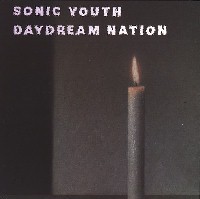

blast first vinyl w/ signed poster
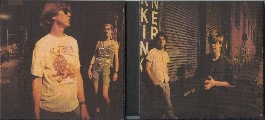
2007 deluxe edition inside covers

2007 deluxe edition booklet 10

2007 deluxe edition booklet 11
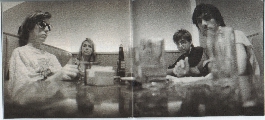
2007 deluxe edition booklet 12
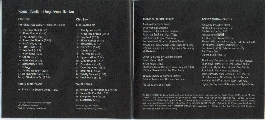
2007 deluxe edition booklet 13
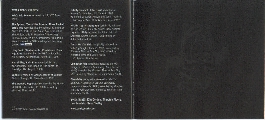
2007 deluxe edition booklet 14
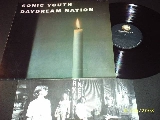
brazilian single LP containing all songs








